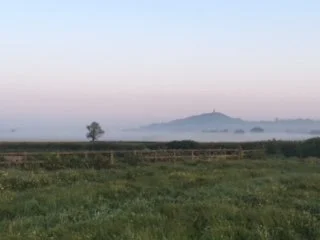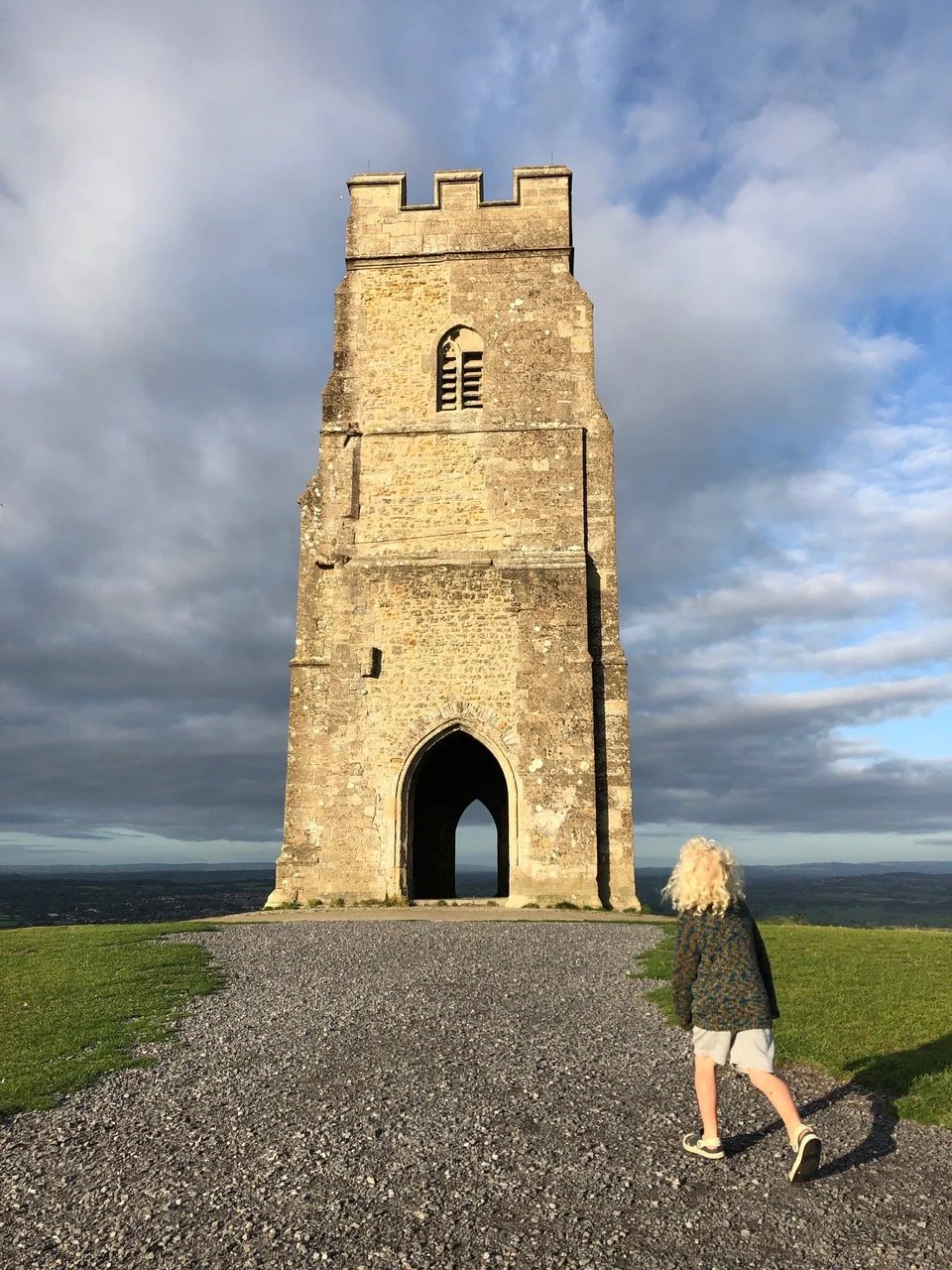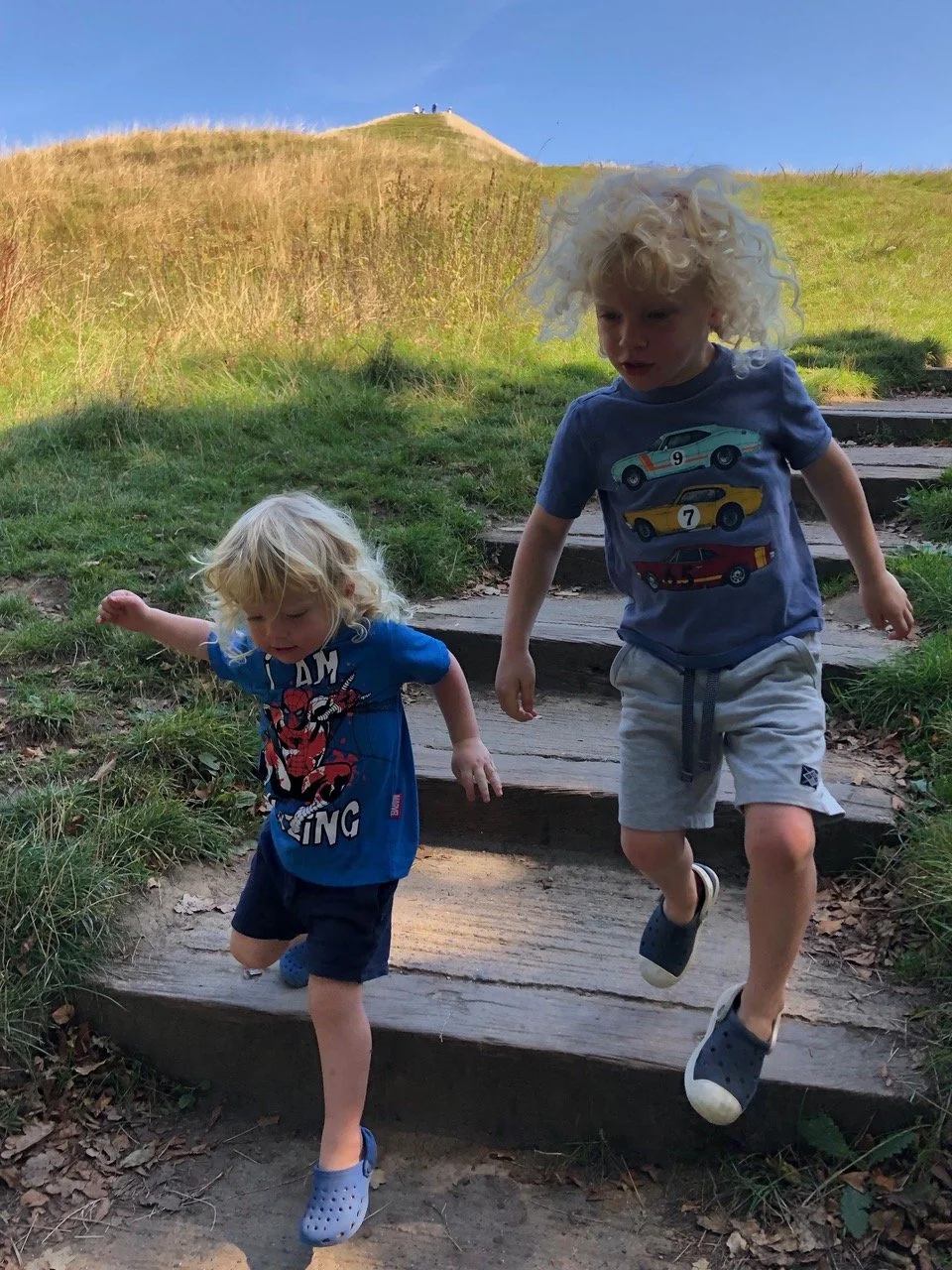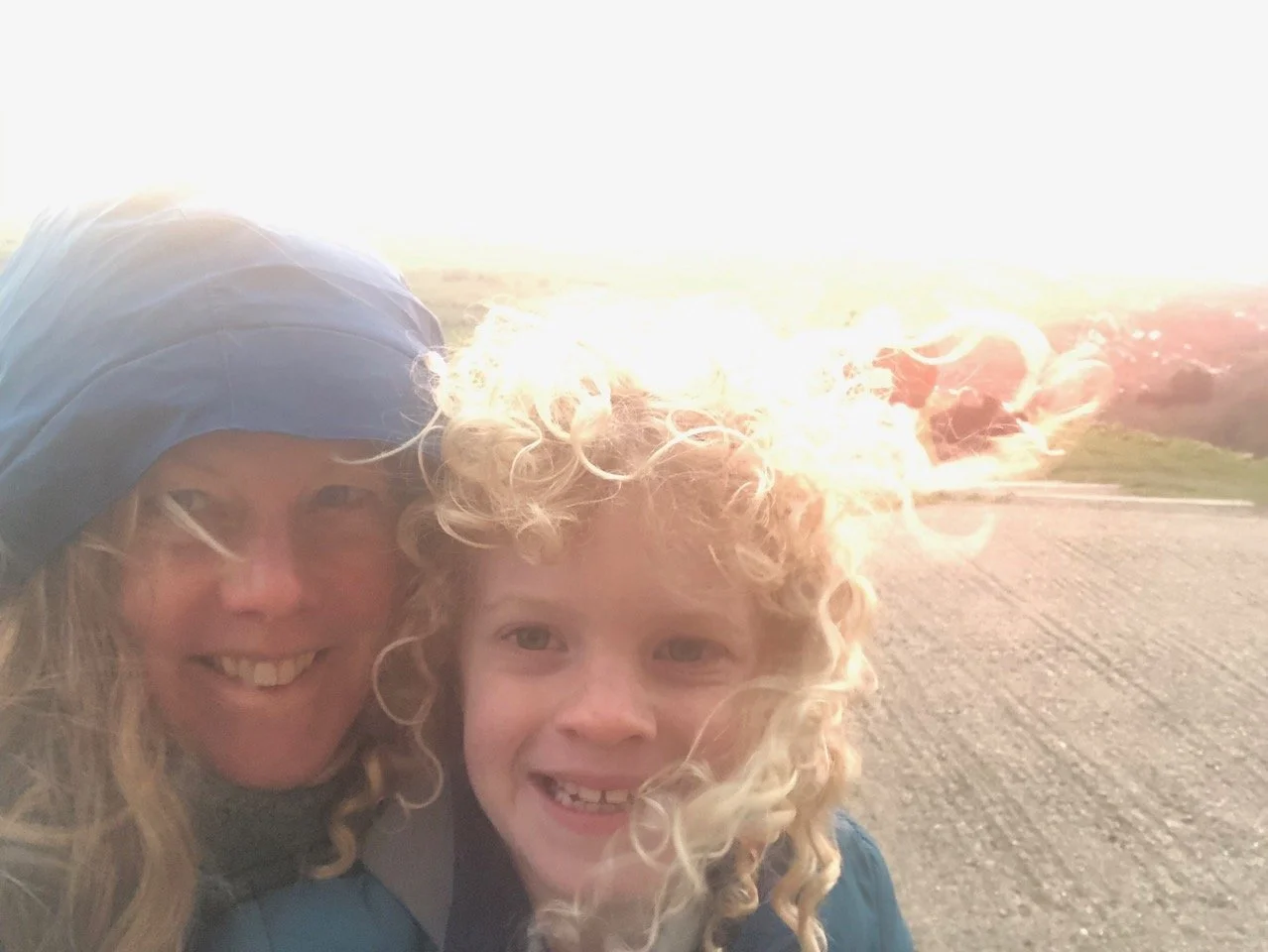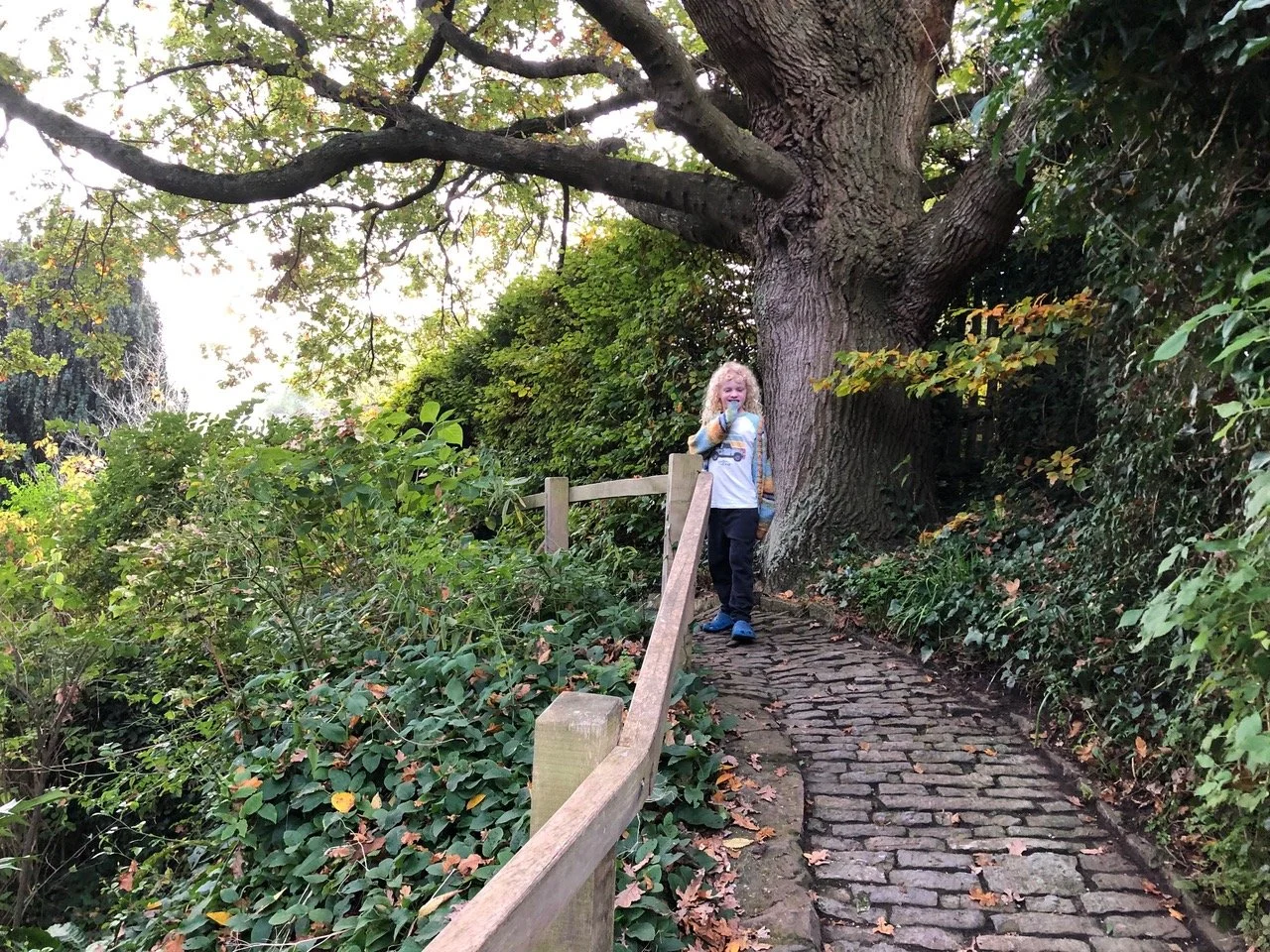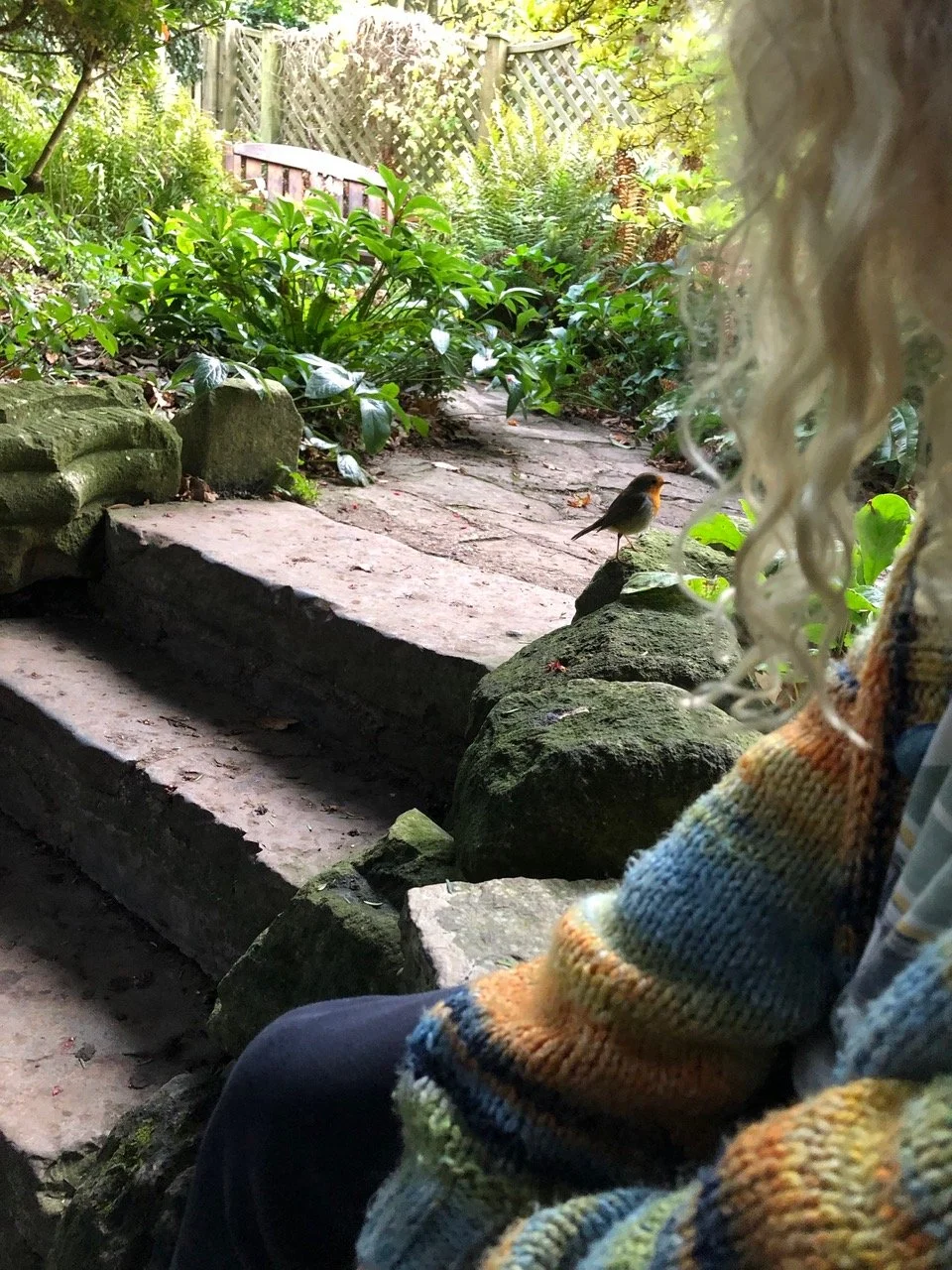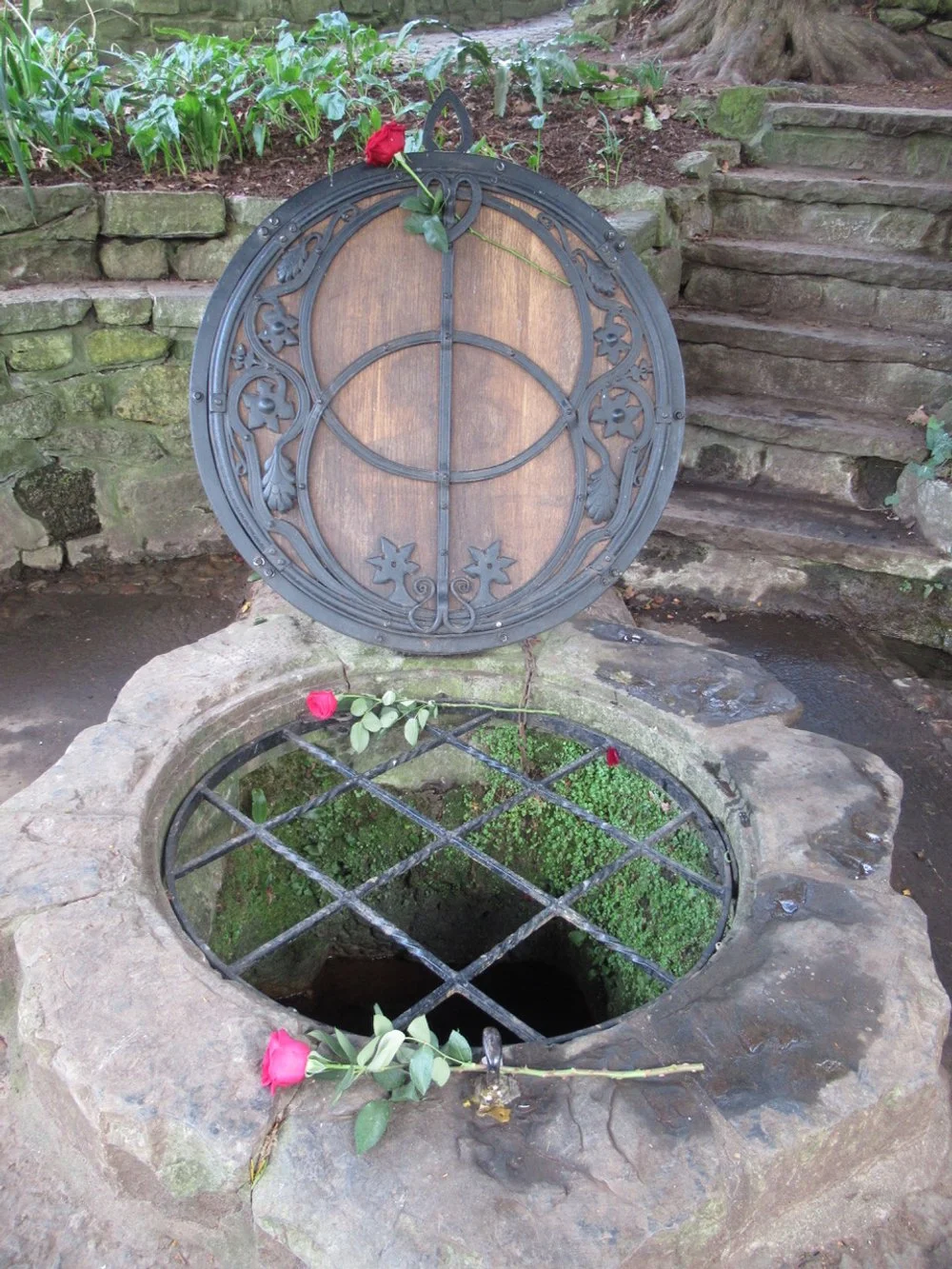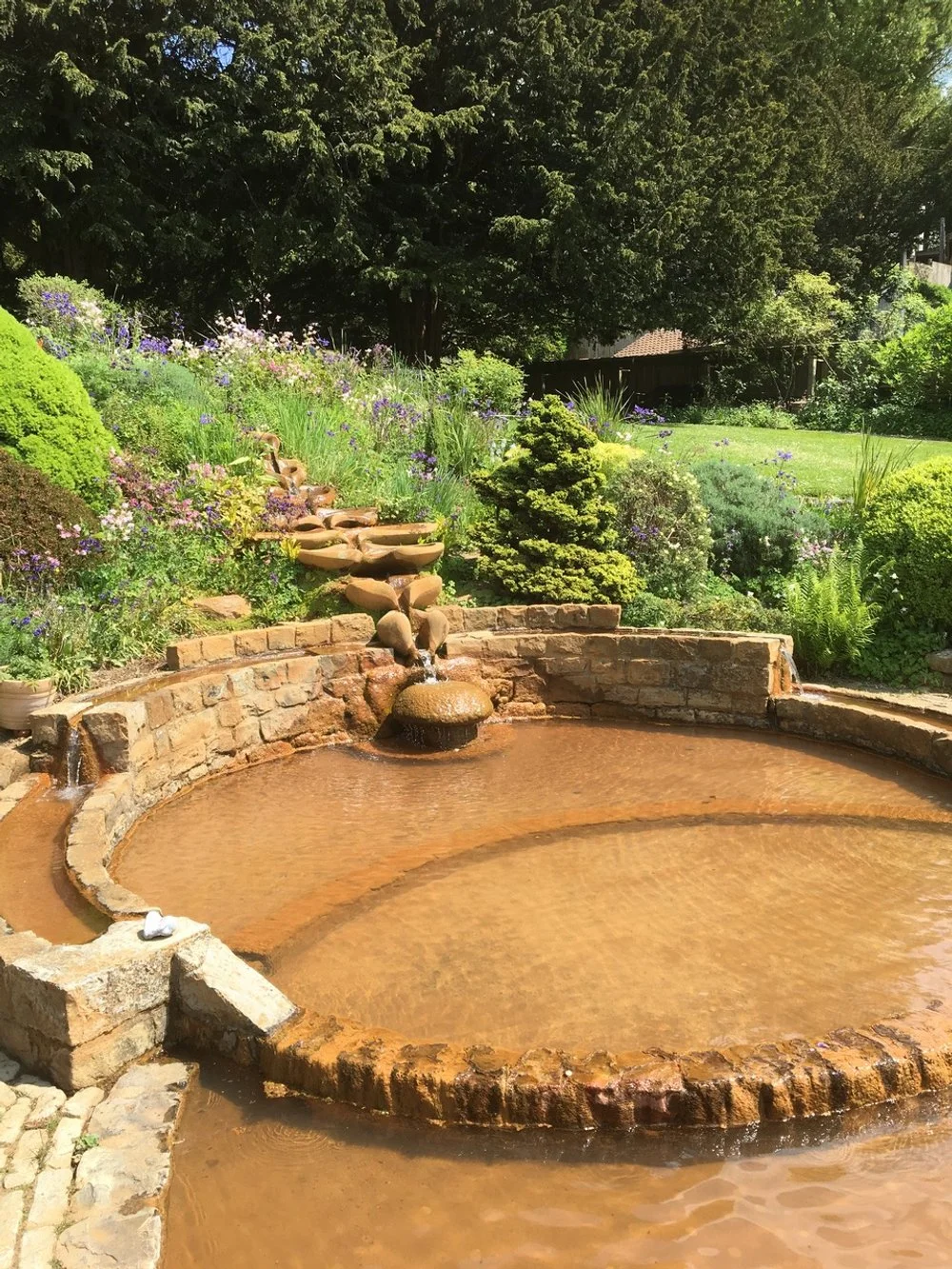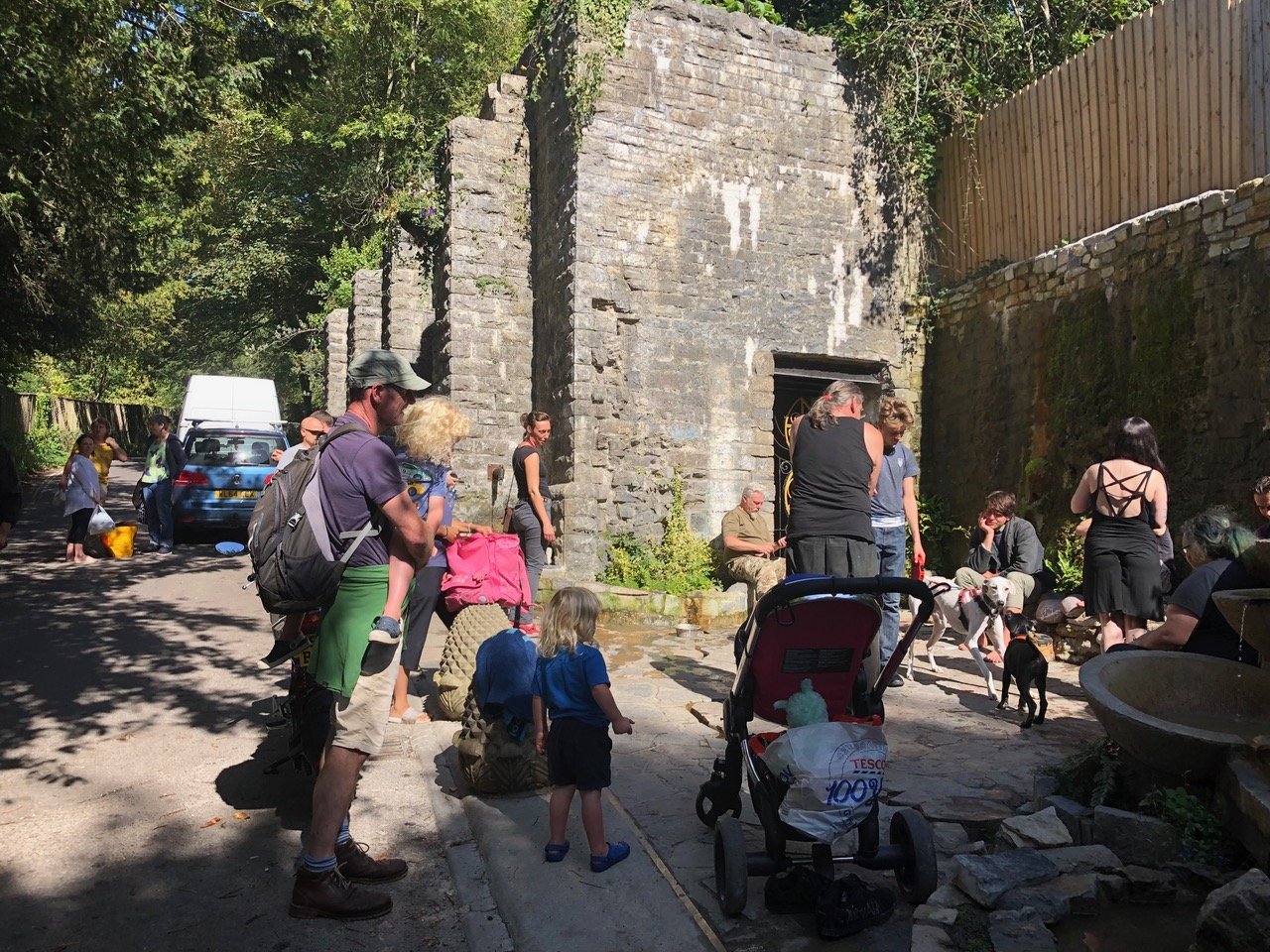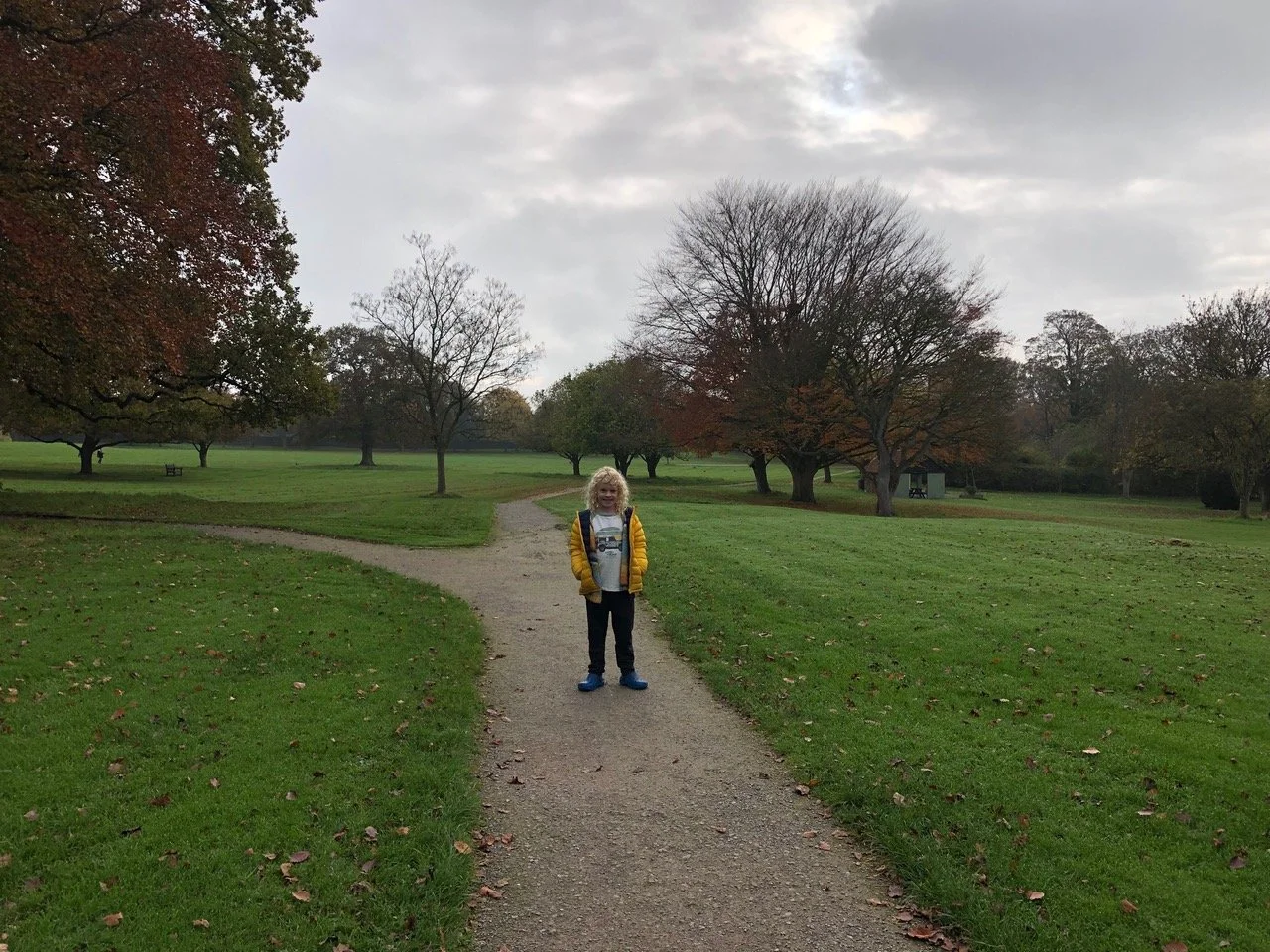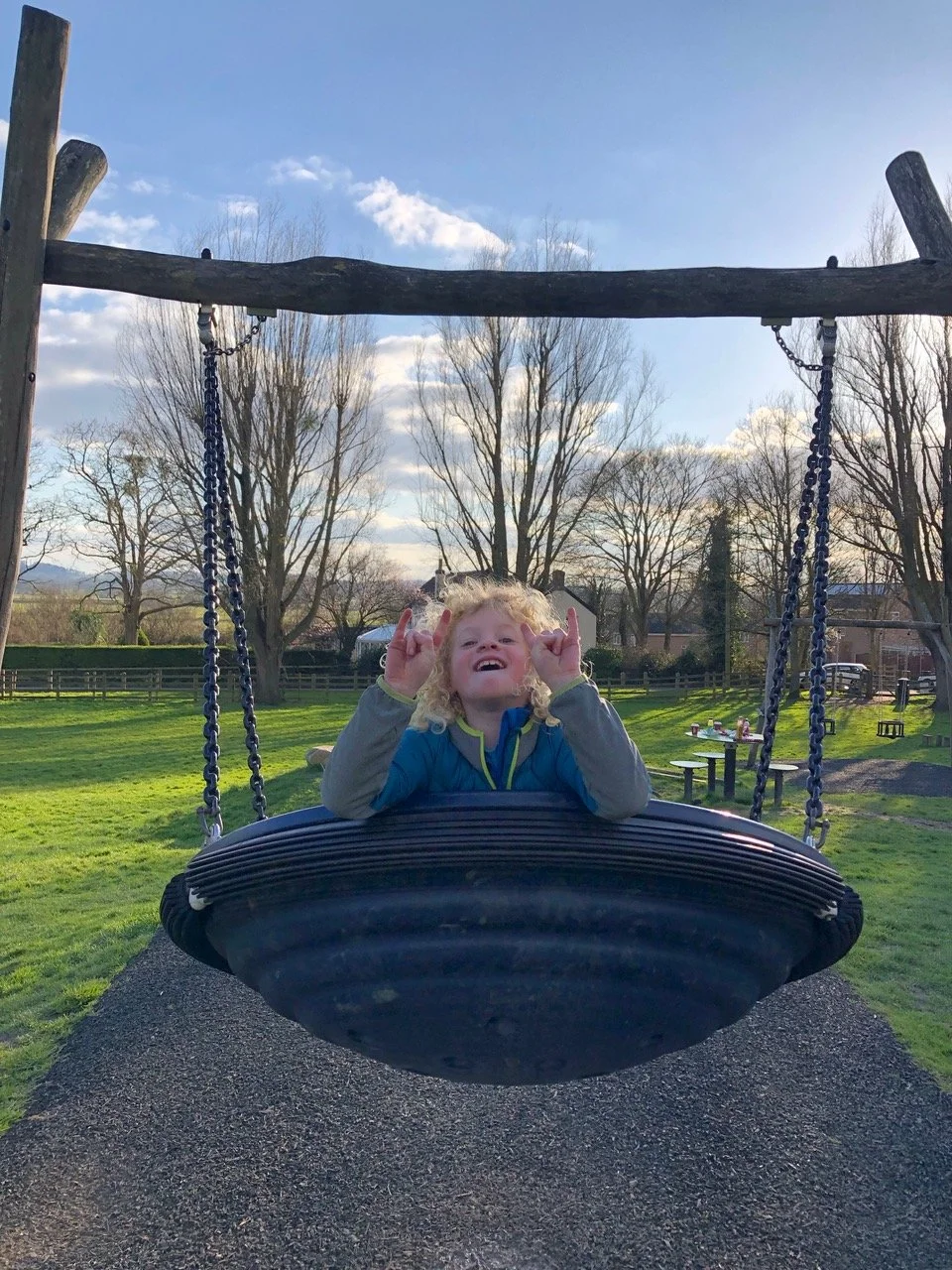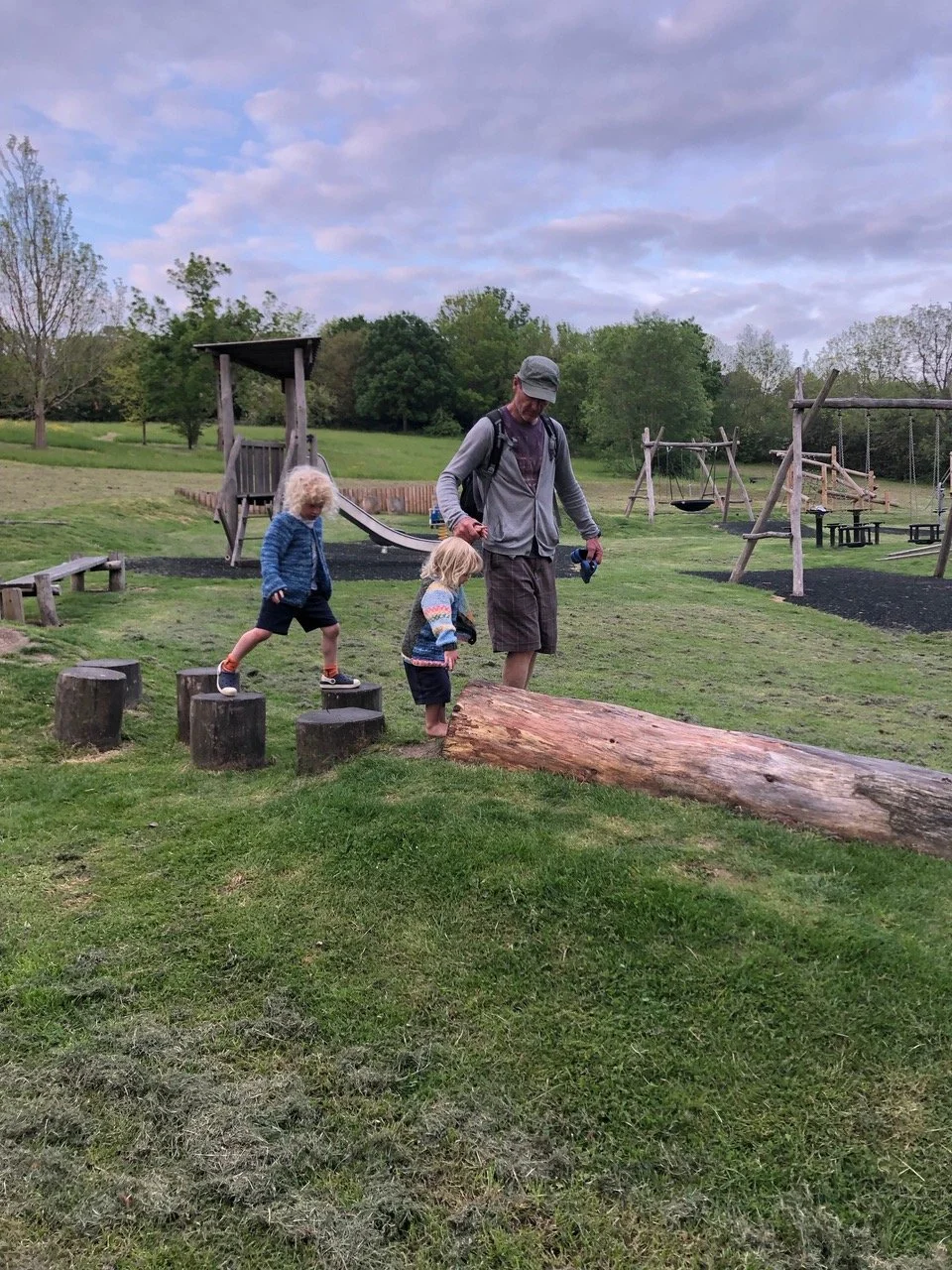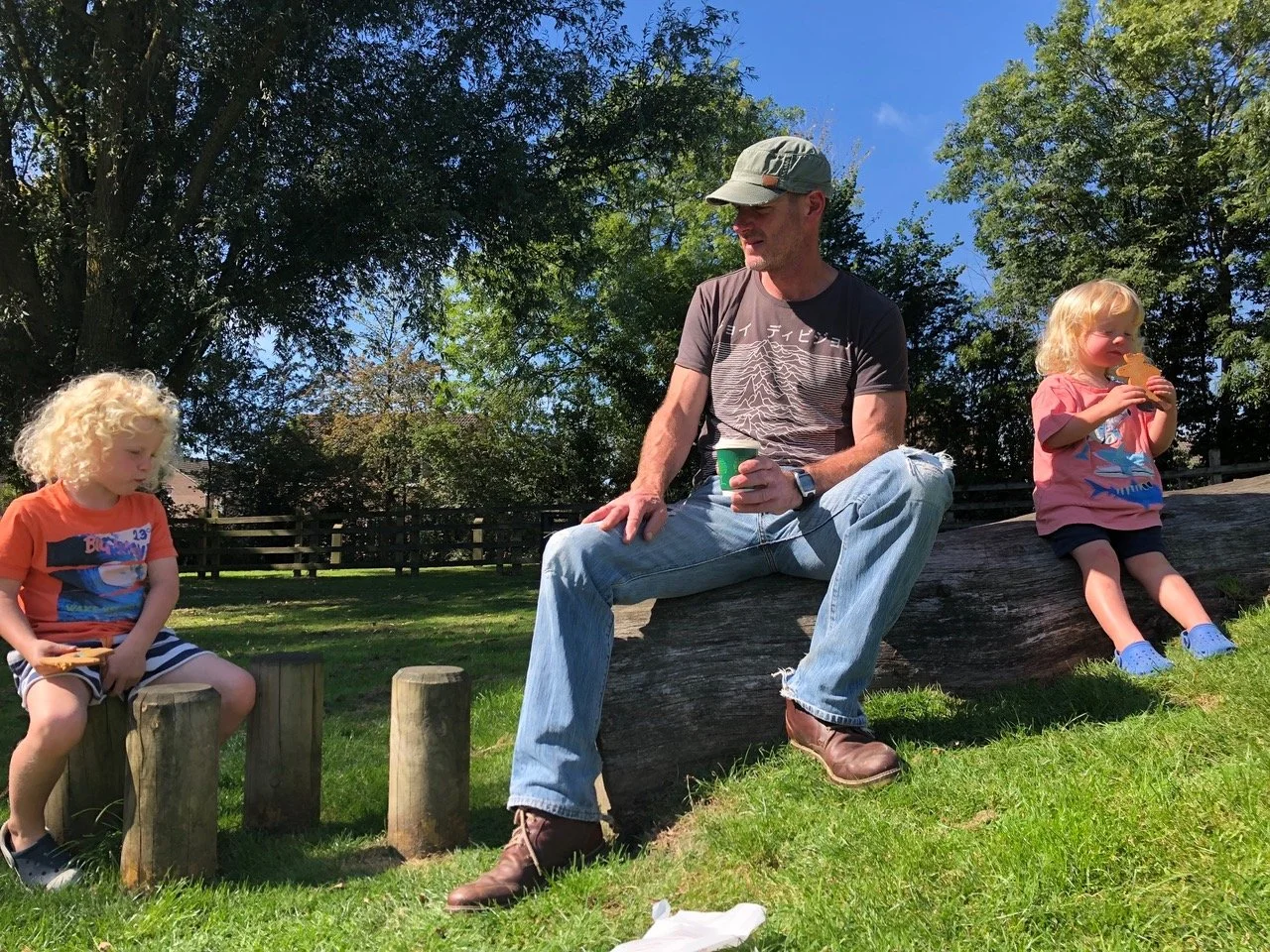My quirky guide to Glastonbury
The mists of Avalon, view from Lower Coxbridge House
I’ve been meaning to write about this for ages as many of you have asked me directly and I always kept thinking that rather than repeating myself a blog is required. Glastonbury has been on my mind all day, so I guess this is as good a time as any!
Glastonbury is a little bit like Sark and Byron Bay. All three places are very sacred, the land is infused with a magical energy, yet many will never see beyond the superficial and even fewer will access the deeper realms that each offer.
In Sark, for example, many will never venture beyond the Bel Air Inn. Others won’t make it to Little Sark either and of those that do, few will ever get beyond the Venus Pool and out to the dolmen and fewer still will walk the land at night, entering its ethereal realms, the wells, especially, coming alive. In Byron Bay, many will see it solely as a party town on the backpacker trail, or somewhere you go to surf. Others might take a yoga class, but not everyone will allow themselves to be touched by its deep healing energy, sacred to the Aborigines, a vortex, which can spin your life a different direction.
Glastonbury has many different sides to it too. Many will never see beyond the commercialism of the crystal shops, plethora of charity shops and the various metaphysical book shops. Some won’t make it beyond lunch in one of the many vegetarian cafes. Others will be side tracked by the witches and wizards, the gypsies and the priestesses and conclude it a crazy town. Other will be intimidated by the counterculture and locals who hang out on the high street, some playing tunes and others just sitting and chatting, the smell of pot sometimes permeating the air, a few homeless begging, and they’ll leave believing that’s all Glastonbury has to offer.
Eben with his handmade wizard wand bought from Wild Wood on Glastonbury high street
But the thing is Glastonbury has so much to offer, it just depends on the energy that you are putting out when you visit and your own conditioning and openness to the ethereal, other worldly and indeed true spirit. Many people are surprised simply because they expect Glastonbury to be more spiritual and less commercial, but true spirit can not be seen so easily simply because it is not trying to be seen - it lives in the ordinary, beyond all that is visible on the surface to much deeper realms both within side ourselves and within Avalon too.
For those who don’t know, Glastonbury its not just a music festival, albeit a musical festival does take place on the outskirts of Glastonbury each June. Glastonbury is actually a mystical town in Somerset going back into the mists of time. In ancient times Glastonbury (Glass-town-borough) and the surrounding hills were islands in a swampy inland sea called the Sea of Glass. Glastonbury was also variously called the Isle of Avalon, Apple Orchard, and the Isle of Glass. Spiritual sites and power spots surround Glastonbury and the various ley lines weave their magical spiritual energies together creating a beautiful ambiance of peace and joy, at least if you are open to experiencing it.
Glastonbury is a magical mirror too, and it will mirror back to us what we are putting out. This might explain why people have such different experiences when visiting. However, as the heart chakra of the world, Glastonbury has always been kind to me, it has an energy which hugely resonates offering an entrance point into higher dimensions, and it is this which draws healers and other spiritual pilgrims from all over the planet, and those who come and don’t know why and will only later discover a side to themselves that has a Glastonbury resonance.
Elijah at St. Michael’s Tower
The distinctive hill of Glastonbury Tor surmounted by its iconic church tower of St Michael dominates the horizon for miles around and acts almost like a magnet, drawing people to it. With the ruins of the once-powerful mediaeval abbey still standing in the heart of the town, the whole area is extraordinarily rich in magic and myth and closely linked to Arthurian legend and Jesus and the Holy grail too.
There is a widespread belief that Glastonbury is the magical (this word will appear lots when I write about Glastonbury!) Isle of Avalon where the wounded Arthur was taken after his final battle. I’m not excited about Arthurian legend, but when the mists of Avalon roll in, as I have witnessed many times, and conceal the lowlands so that all you can see is the Tor rising above a blanket of white mist, then Glastonbury does indeed resemble an island.
Ewan and Elijah headed up the Tor (again!)
Standing proud and iconic on the summit of Glastonbury Tor is the mediaeval tower and all that remains of a church once dedicated to Archangel Michael. The Tor sits on the St. Michael's Ley, which has a Neolithic provenance, and is known as one of the celtic 'Perpetual Choirs', said to maintain the spiritual integrity of Britain. The primeval mound was a fundamental theme in prehistory, and as mentioned earlier, Glastonbury was surrounded by water until the Somerset flats were drained in the 4th century.
Up the Tor
St Michael’s ley line is one of two powerful ley lines within the UK, the other one being the Mary line. The Michael line was first mapped by John Michell and crosses England from east to west, starting near Great Yarmouth in Norfolk and ending at St Michael’s mount on the western tip of Cornwall. The Mary line is thought to be more meandering and entwines around the Michael line, meeting at certain points. Dowsers say that the energies they feel for each line are different - the Michael line is solar and masculine while the Mary line is lunar and feminine.
Dowsers, Paul Broadhurst and Hamish Miller, followed these two lines in their entirety and wrote about their findings in their book The Sun and the Serpent. I have read the book and was fascinated to find that the pair traced both the Michael and Mary energy lines climbing the Tor in a labyrinth manner forming two interlocking shapes at the summit suggesting a chalice & probe (Cove & Obelisk perhaps) or sexual union. This fits beautifully with my interest in alchemy and might account for the reason that so many are drawn to the Tor in the first place - magic happens here and interestingly on Beltane too, which is one of the most potent times of year from a fertility and creative perspective (think maypole).
Running down the Tor
Beltane is also known as May Day and the Michael’s line is in close alignment to the May day sunrise, which is celebrated annually in Glastonbury. It’s been suggested that the rising of the sun on the Beltane could have coincided with beacons lit along the Michael line to celebrate it. Others say that the line follows the direction of sunrise on the 8th May, the spring festival of St Michael. I have yet to feel into the energy of Beltane in Glastonbury or indeed on May 8th but have the intention to do so one day so will let you know. I have dowsed the St Michael line out at Avebury, and love lying on the earth at the Serpentine, where the Mary line entwines the Michale line - there is something magical about the energy of the union of the divine masculine and feminine, harmony!
I did find myself traipsing off the Tor a different way on my trip with Elijah last June, just before we headed to Stonehenge for the summer solstice and it did humour me that we unintentionally found our way to Dods Lane, which is meant to be the ancient trackway from Glastonbury Abbey all the way to Stonehenge, this in alignment with our trip and highlighting again to me that Glastonbury has this deeper element to it that reveals itself when the time is right and that there are all these sacred connections across the country, like a crystal grid magnifying energies.
Elijah and I sunset from the Tor
Maybe it was around then I learned of a winter solstice alignment from one of the nearby hills where you stand and witness the winter solstice sun rolling up the Tor, which is just one of the many wonderful reasons that the ancients sculptured the land, to make a play with the sun and the moon and capture the essence of both. Annoyingly we were once there on a 24 hour visit for the winter solstice but I didn’t know about that alignment, I just got cheap flights and wanted to do something different…Being in Glastonbury naturally aligns you more fully to the sun and the moon and I have witnessed some spectacular sunsets, sunrises and moon rises too while in town - my photo album is full of them.
There is a hidden cave beneath the Tor through which you can pass into the fairy realm of Annwn and there dwells Gwyn ab Nubbiest, the lord of the Celtic underworld, with the Cauldron of Rebirth. This I like to think of as the White Spring, which I’ll write about more later, as certainly a rebirth of sorts takes place when you dip in the cold waters. Definitely there is an ethereal realm that reveals itself if you attuned to it and vibrating appropriately, no easy feat in this heavy world of technology and 4 and 5G, let alone the general heaviness in our individual energy fields, but alas it is a possibility however crazy it may sound.
It is thought by some that the hill was artificially shaped into its present form, an idea which finds favour in the seven-levelled ritual terraced pathway that winds up the Tor. This is suggested to have been a deliberate pathway, either designed to entrap passing spirits, which were believed to travel in straight lines (ley-lines) as mentioned earlier or, as a ritual pathway (labyrinth) for pilgrims. I haven’t walked the labyrinth as I usually have children with me on any visit to Glastonbury but it is on my list of things to do as one of my friend’s has done it and says it is quite an experience. There is an egg stone on the Tor, which most miss as it is the other side from the main path and this signifies the entrance to this other realm that the Tor offers.
As mentioned earlier, Glastonbury abounds in myths and legends and two significant ones concern Joseph of Arimathea and King Arthur. Joseph was the Biblical figure who took Jesus' body after the crucifixion. According to some legends he was actually Jesus' uncle and had visited Britain years before with Jesus in the pursuit of his interests in the tin trade. It appears that there actually was a strong Jewish presence in the west of England at that time, and many of the tin miners may have been Jewish settlers.
In any case, when Jesus died, Joseph thought it prudent to flee Palestine, and after many travels, he came to Britain with a company of followers including Mary, mother of Jesus and Mary Magdalene, more on her below. He brought with him the Holy Grail, the cup used by Jesus at the Last Supper. Some versions of the legend have it that the Grail contained two drops of blood captured from Jesus' side when he was wounded on the cross.
When Joseph came to Britain he was granted land at Glastonbury by the local king. When he arrived at Glastonbury, Joseph stuck his thorn staff in the earth at Wearyall Hill, whereupon it rooted and burst into bloom. A cutting from that first tree was planted in the grounds of the later Glastonbury Abbey, where it continued to bloom every year thereafter at Christmas time. More on this to follow.
Joseph was said to have established the first church in England at Glastonbury, and archaeological records show that there may well have been an extremely early Christian church here. What happened to the Holy Grail is another matter. Some legends suggest that Joseph buried the Grail at the foot of the Tor, whereupon a spring of blood gushed forth from the ground.
There is a well at the base of the Tor, in the form of Chalice Well, and the water that issues from it does indeed have a reddish tinge to it, from the iron content of the water, more on that to follow too. Other legends suggest that the Holy Grail was interred with Joseph when he died, in a secret grave. The search for the mysterious Grail emerges throughout the tales of Glastonbury.
Meanwhile the association of Arthur and Glastonbury goes back at least to the early Middle Ages. In the late 12th century the monks of Glastonbury Abbey announced that they had found the grave of Arthur and Guinivere, his queen. According to the monks, an excavation found a stone inscribed ‘Here lies Arthur, king.’ Below the stone, they found the bones of a large man and the smaller skeleton of a woman. The monks reburied the bones in the grounds of the Abbey, where they were a very handy draw for pilgrims. The site of the grave can be seen today in the Abbey grounds.
While I’m on the subject, one final myth of Arthur at Glastonbury includes the suggestion that the landscape around Glastonbury has been moulded and shaped so that the features including roads, churches, and burial mounds create a zodiac calendar replete with Arthurian symbology. But of course like all myth, this is all open to one’s interpretation.
Glastonbury has a particular association with Mary Magdalene and many women will come to town seeking her divine presence and that aspect within themselves and some believe themselves to be a reincarnation of her and come seeking familiarity. For those unaware, Mary is believed to be the partner of Jesus and mother of their daughter, Sarah. She is also renowned for being a gifted healer and spiritual devotee.
Certainly if you are on a Mary Magdalene quest then you will likely find yourself in the Abbey and also St Margaret’s Chapel, as well as the various springs and wells. Lisa Lister and Rebecca Campbell both reference Mary Magdalene in their books and if you are curious then I recommend reading Claire Heartsong’s channelled books Anna, The Grandmother of Jesus: A Message of Wisdom and Love and Anna: The Voice of the Magdalenes as well as Megan Watterson’s Mary Magdalene Revealed: The First Apostle, Her Feminist Gospel & the Christianity We Haven't Tried Yet .
I first visited Glastonbury when I was 20, in my final year of university and with my best friend at the time. I just had this feeling I wanted to visit the place. I was a little bit different even then, before I came back to Guernsey and tried to fit in. I smoked pot, I liked wearing hippie clothes, I surfed, I wrote poetry, I liked staying up late on my own staring at the stars and listening to music. I don’t know what drew me to Glastonbury especially, and I don’t remember doing much while we were there. I was a bit disappointed really as I imagined us sitting in a cafe with other alternative types smoking pot, but I think my friend and I sat there alone, drinking tea instead.
I found myself back in Glastonbury again when Elijah was 3 months old. We walked through the town initially, Elijah in a sling, looking for the Rainbow cafe, a vegetarian place, which had been recommended. On the high street, a witchy lady suddenly appeared in front of me and told me not to vaccinate Elijah. I’ve never forgotten that moment as she appeared from nowhere and disappeared as quickly too. I had no intention of vaccinating him, but I was feeling the pressure of continuously defending myself to opinionated people and her approaching me like this, while very strange, was the validation I needed to stand true to my gut on this one.
We made it up the Tor that trip, the first time of many, wind swept, but invigorated, there is definitely something about the Tor that makes one feel profoundly more connected, maybe to the heart of the world, certainly if I am feeling disconnected I find myself dreaming of the Tor and getting up it. You never know what you might find at the top, every trip is different depending on the time of the day, sometimes there’s Kirtan or drumming, the smell of pot or frankincense might permeate the air, maybe people are making offerings or holding ceremony and sometimes people are simply trying to shelter from the crazy winds which can whip over the hill.
Something about Glastonbury was getting under my skin and we found ourselves back there again, for a few days this time, when I was awaiting embryo transfer following a frozen IVF cycle (you can read all about this in my book Dancing with the Moon. I went for angel Reik, or something similar, up in a room in someone’s house just off the hight street. I remember feeling that the energy was all wrong, that the Reiki wasn’t as grounded as I needed it to be, and I left feeing even more flighty than when I arrived. It didn't help that I knew the lady knew that I wasn’t ready for this IVF cycle, that there as no soul waiting to come in, that I was indeed ungrounded and too up in the air myself energetically, life all over the place at that time.
Still, while I didn't conceive on that cycle, it was the wake up call I needed to get myself back to earth again and sort myself out, having lost my way with the pressures of early motherhood and a strained relationship with self as much as with E. Something else positive did come of this trip though, in that spirit directed me to Lower Coxbridge House and Sarah Orme, who is now a friend. Sarah is a fellow yoga teacher and at that time was renting her property for small and intimate yoga retreats. I just knew I had to run a retreat, not least to encourage more Guernsey folk to this sacred place but to have an excuse to immerse myself more in the energy of it too.
Elijah jumping at Lower Coxbridge House, with beautiful skies (I have a significant number of photos of sunrise and sunset from here and even full moon!)
Ten months later and in the early stages of pregnancy and feeling decidedly nauseas and tired, I ran my first yoga and wellbeing retreat in Glastonbury - well at Lower Coxbridge, three miles away from Glastonbury but with magnificent views of the Tor and on some energy vortex that had me and another student ‘travelling’ during a Kirtan session. That was the first of many retreats that I ran there, and many of my students joined me many times over as it is such a magical spot. That trip was all about sussing it out with my students, getting up the Tor, visiting the Abbey and of course enjoying the crystal shops too.
Like Elijah, Eben first got to visit Glastonbury when he was just over three months old. I was in the UK to celebrate Steph’s 21st birthday down in Exeter and I had a few hours to spare and thought I’d pop up to Glastonbury. I didn’t know why, beyond getting up the Tor, and visiting a crystal shop or two. This time though I found myself at Chalice Wells, which might have been my first visit, or at least the first time the place had called me to it.
Elijah at Chalice Wells
It wasn't until I was in Chalice Wells and reading up on the place and the red iron water that I realised the reason I has been drawn there - I was iron deficient post-natal and needed the iron, plus it’s a tonic for a tired and weary soul and mine was definitely both. This is the thing with Glastonbury, you might have an idea of what you want to do, but the place will direct you if you allow it. On my last trip, in February, at the last minute I found myself drawn into Chalice Wells and £3.60 later (£1.80 per child), I realised that just five minutes of the peace that it provides is sometimes all that is needed to refresh before a journey home (I thought I was just popping to the White Spring to gather water while the children played with Ewan…)
Chalice Wells lies in a protected area of natural beauty, at the foot of a narrow valley running between the Tor and Chalice Hill and is most definitely an integral part of the sacred landscape of Glastonbury. For over two thousand years the Red Spring, or Blood Spring as it is often known, has flowed here and it is a place where people have gathered to drink the waters and find solace, peace, inspiration and, ultimately, healing.
Elijah by Chalice Well with the robin!
In 1959 Wellesley Tudor Pole, secured the Well and surrounding land for the future, creating the Chalice Well Trust, which continues to run the site today, with many lovely volunteers giving their time freely to help. His intention was to preserve the whole area as a sacred site to ‘encourage individual spiritual evolution by offering this place to members of the public, of whatever religious persuasion or none, for pilgrimage, quiet contemplation and healing’.
Needless to say, there are many legends associated with Chalice Wells. Many believe that the waters represent the blood of Christ, which miraculously sprung forth from the ground when Joseph of Arimathea buried or washed the cup used at the Last Supper. For others the waters are seen as the essence of life, a gift from Mother Earth to sustain living beings, with springs being a direct expression of her generosity and unbounded life force energy.
Chalice Well and the Vesica Piscis
Apparently, the archaeologist Bligh Bond designed and gifted the wellhead cover. It depicts the Vesica Piscis, an ancient sacred symbol of transformation and maybe it is this alone and the energy it creates that draws people to it. I would urge you to visit it if you are in town. This magical symbol is visible in several places in the gardens and reminds us of the duality of existence and the quest for unity - thus not buying into the bag/good, right/wrong, fail/success conditioning that has us constantly separating and dividing, if not within ourselves then with others.
The red iron water flows through the length of the gardens and appearing in different forms: at the well, as a fountain at the Lion’s Head where you can collect the water for drinking (you can collect it outside Chalice wells, just opposite the White Spring), as a waterfall in Arthur’s Court flowing into the healing pool where you can foot bathe, before rushing down through the flow-form in the lower gardens collecting in the Vesica Pool before leaving the site and continuing on its underground way towards the Abbey.
The lower gardens at Chalice Wells
In the gardens there are several Holy Thorn trees, believed to have descended from the original Holy Thorn planted by Joseph of Arimathea. We did make an effort one time to traipse out to Wearywall Hill, because - as written earlier - this is where Joseph of Arimathea supposedly climbed on his arrival in Britain and, exhausted, thrust his staff into the ground and rested. By morning his staff had taken root and grown into a miraculous thorn tree that bloomed twice a year. Unless you particularly want to get out to Wearywall Hill then the Holy Thorns at Chalice Wells or the Abbey might well suffice!
Chalice Wells is also one of the meeting places of the Michael and Mary lines and I suspect it is this union, which creates such magical energy. I loved the energy of Chalice Wells on that first visit, it is so serene and peaceful and being a lover of water and wells especially, I found it deeply soothing and healing - and still do.. I love the goddess figurines scattered throughout the place too and no doubt that visit, helped to further awaken my connection to her energy, as she had only drawn me to her three months earlier on the eve of Eben’s birth, as you can read about in my book Dancing with the Moon.
In Chalice Wells
Visiting Chalice Wells should be on everyone’s itinerary, not least as a a welcome relief on a busy Saturday in town (one is encouraged to turn off mobile telephones and keep noise an absolute minimum) but because the gardens themselves and the flowers, shrubs and trees are beautiful. Take your tea or lunch there! I have spent many happy moments sitting by the well itself and imbuing its energy and the peace and quiet, watching the robin which inevitably appears, enjoying the goddess undertone and feeling my heart opened by the experience.
It was probably my increasing fascination and love for goddess and goddess energy that was drawing me to the town and each time I visited I found myself leaving with a new Goddess figurine, representing and containing the quality of something - I now realise - I was trying to access and embody at that time. My interest in Goddess figurines led me to partake in an online course all about Goddess culture and representation on landscape and in sculptures and figurines too. Kathy Jones, Priestess of Avalon and founder of The Glastonbury Goddess House and Temple.
I have always been fascinated by landscape. I studied landscape and culture within my geography degree and had signed up to specialise in this post-graduate, but it wasn’t the right environment for me, and I let it go for many years. However it has woven its way back into my life as many of you regular readers will know as I am fascinated by the neolithic landscape especially, because of its sacredness and the manner in which it affects and effects consciousness and allows access to other realms and other entities should one wish (I have always been fascinated by, and drawn to fairy realm, for example, and Guernsey of course has a rich fairy history)
I have also become increasingly passionate about the neolithic stones themselves and rock art and there is nothing more special than a goddess, and here on Guernsey we are so very, very lucky to have two incredible neolithic Goddess menhirs and a Goddess temple to boot! I’m not sure people realise how unusual and magical that is - Guernsey’s very sacred, if you can get beyond the materialism and capitalism that flourishes here nowadays. I found the course with Kathy really inspiring (especially as it took place during lock down when I couldn’t get to Glastonbury) as I learned lots more about Goddess landscape and culture and about the various figurines that have been discovered over the years.
Anyway, we were back all four of us a few months later, in the May, Eben eight months old by then and Elijah three for mummy’s second Glastonbury yoga & wellbeing retreat, camping out in one of the amazing yurts at Lower Coxbridge House, affording awe-inspiring views of the Tor through the open door while lying in bed. They were yet more magical times, barefoot on earth, in touch with the moon, the sun the stars (peeing under moonlight and hearing the owls overhead, let alone the baaing sheep in the fields!), yummy vegan food on retreat and lovely people to chatter with. E was marvellously supportive and patient, entertaining both boys for up to four hours a day while I taught and us managing the expressing/breast and bottle feeding that was required at that stage, let alone all the nappy changes, but this for the love of sharing Glastonbury with others and because he and the boys both enjoy the place too.
Back in the day…running a yoga and wellbeing retreat at Lower Coxbridge House with boys so little, yurts in background and Tor beyond
It was on that trip that the White Spring came into my world. It was referenced in one of Lisa Lister’s books, which I happened to be reading on the boat on the way over to the UK, a day before the Glastonbury retreat. I couldn't believe I had not heard about it previously, but this is the thing with Glastonbury, it gives a little bit more of itself each time we visit. The White Spring though has become one of my most favourite places on this earth and it was the first place I visited post-lock-down, albeit on reduced hours at the time, with Elijah in tow for a mummy and Elijah spiritual pilgrimage to Avebury and Stonehenge too.
Others don’t necessarily get the appeal of the White Spring and struggle to see beyond those hanging outside the entrance to the Spring, playing hang drums, smoking pot and collecting spring water. Inside it’s dark but for the many tea light and the natural light that comes in through the doors. It echoes too, which is absolutely amazing if someone is playing the drums or singing, but my boys, for example, find it all too much. However I just LOVE it and when things get too much here, I find myself planning a return trip, and imagining myself immersing in the spring water and that lovely space.
The thing is, a trip to Glastonbury is quite easy from Guernsey. We have gone on the boat and taken our own car, which might well work out cheaper, but is a bit of a hassle. Instead I prefer to fly to Exeter which sometimes only takes 45 minutes on a direct flight (sometimes you have to go via Bristol so it takes 1.5 hours instead) and hire a car. On a clear run I have managed to get to Glastonbury within an hour of leaving the airport, up the M5 and then on the A39. It’s really easy, which makes it all the more tempting!. During the pandemic, we flew through Southampton, which means a 2-2.5 hour drive instead, and much more traffic.
Ewan and the boys outside the White Spring
Anyway, there is something about the White Spring that just positively changes things for me. Located next to Chalice Well, in Well House Lane, the site of the White Spring is steeped in history and mythology, the antiquarians said that stone foundations could be seen and possibly the remnants of monk’s cells. It’s also thought to be the entrance to the underworld of Gwyn ap Nudd as referenced earlier.
The building of a reservoir over an attractive combe, by the Water Board in 1872, was met with huge opposition from local antiquarians, objecting to the destruction of a popular beauty spot much frequented by locals. However, after building the reservoir, the Water board soon discovered that the high calciferous content of the water caused pipes to block and by the end of the 19th century water was piped into Glastonbury from out of town.
After lying derelict for many years, the Water Board sold the White Spring to the White Spring Glastonbury Foundation and now the temple is created by, cared for and supported by the Companions of the White Spring. This includes men and women who give their time and resources freely, for the love of it, and find their lives blessed because of it. In keeping with their belief in the sacredness of all creation they endeavor only to use natural and pre-used materials. They receive no state funding and while donations are not expected, I would encourage anyone visiting to donate generously.
Eben inside the White Spring (bit naughty as you’re not meant to take photos, mainly because of people bathing naked)
It was the pump house that was converted into a temple space, created in gratitude for the gift of pure water. In blackness or candle lit, the White Spring offers a wonderful contrast to the sunlit gardens of Chalice Well literally across the road and separated from the wall that surrounds the land owned now by the Chalice Wells Trust. With its constant temperature and the sound of the perpetually flowing water, it really is a very unique and sacred space - even Ewan takes a dip in here and I have shared the space with many lovely students on retreat.
A series of pools have been built according to the principles of sacred geometry, and simple shrines in honour of the ancient energies and spirits of Avalon have been created within the temple. All of this is enhanced by the Michael line which flows through this place from Chalice Wells and up to the Tor as referenced earlier. In fact, it is one of the greatest mysteries of the Isle of Avalon is that two different healing springs, one touched red with iron, the other white with calcite, should rise within a few feet of each other from the caverns beneath Glastonbury Tor, both healing too.
Eben collecting the red water
On the wall outside the White Spring is a tap to collect its calciferous water and across the road is another tap, this one to collect the iron water from Chalice Wells. Thus you can collect both the red and white water within metres of one another, and many do, people pile up with their huge water canisters from communities and retreat centres nearby and fill on up, taking a break to let us one bottle peeps fill up too. I always leave space in my luggage to bring a 1.5 litre bottle of mixed red and white water back to Guernsey with me and put in a request to anyone visiting, especially with a car to bring water back for me.
Eben collecting the white water outside the White Spring
What I love most though is literally getting in the white water. There are two pools, a wide shallow one that maybe goes half way up my shins and a much deeper and smaller one right at the back, on the left, like a plunge pool. While you can wear bathers if you choose, most people bathe naked. In many respects it’s probably helped give me the confidence over the years to undress in public like this, embracing my body and its nudity and dipping in sight of others. It feels wrong wearing bathers on the beach now is the only thing…
The water is very cold, which is wonderful in the warmer months but a touch testing in winter! But my goodness, it always makes me feel incredibly alive afterwards. I tend to dip before and after going up the Tor. It isn’t open every day so do check before you visit and don’t forget to take a towel - you can wear bathers if you choose. Usually it is open to the public on Tuesdays, Fridays, Saturdays and Sundays from 1-5pm. Tip generously. It is run by volunteers who give so much of their time for free. There is more information here http://www.whitespring.org.uk
On that trip, I was all into the Goddess and I was keen to visit the supposed bleeding stone behind the Abbot’s kitchen in the Abbey grounds, where women were purported to have crouched and bled so that their menstrual blood could be collected. The shaped stone is believed to be a pagan omphalos discovered at the Abbey in the 1910s by architect Frederick Bligh Bond. The ancient Greeks also used ‘omphalos’ to refer to a sacred, rounded stone in the Temple of Delphi denoting the centre of the earth. Many will just call it an egg stone, which has some significance even if it is not entirely clear the nature of that significance.
Elijah at Glastonbury Abbey
The ruins of the Abbey are set in 36 acres peaceful parkland at the centre of the town where Joseph of Arimathea is said to have founded his initial church, the first in Britain and this making it a a particularly holy destination for medieval pilgrims. Of course there is the connection with King Arthur and his second wife Guinevere reference earlier and even today the supposed site of King Arthur’s tomb is marked out with stones in the grass within the abbey ruins.
It’s a beautiful place to visit, serene, and peaceful, with lots of beautiful mature trees and a duck pond too. The boys love it as they can run around at will, but also because it has a certain energy that calms everything! We’ve often gone there just to walk and sit and contemplate. I just read that an adult can take two under 16s for free nowadays which makes it much more affordable. There is often lots going on at the Abbey, we were in town when there was a mediaeval fair, for example, so just check as you may need to book tickets ahead.
Elijah in the Abbey grounds
So it follows that although Glastonbury is an important centre of early Christian history, it was a sacred place before Christianity and its modern pagan communities continue to flourish. As I mentioned earlier, there is a strong Goddess presence in town, helped hugely by the work of Kathy Jones, founder of the Goddess House and Goddess Temple and director of the three year Priestess of Avalon training.
It was certainly all about the Goddess on my next trip, a few months later, with my sister in law, Star, and Eben, still being breastfed at the time. We only visited town for 24 hours but packed a lot into a small amount of time and the focus was definitely on accessing as much Goddess energy as possible. I’m especially fond of the Goddess Temple, which is set upstairs in one of the courtyards off the main high street. It’s not particularly elaborate or anything, but it does have a lovely energy and there is always a fabulous altar encapsulating the energy of the turning of the wheel at any particular time of year. I usually have a child in tow, we light a candle, make a wish, say a prayer and pull an oracle card.
Elijah in the Goddess temple in the autumn
The retreats continued twice yearly up to the pandemic and we squeezed in the odd family trip too. Once we were lucky to housesit for our retreat chef, Olga’s, parents in law one February half term and that time I discovered the treatments at the Goddess House and the Ashram at the foot of the Tor, which has sadly since closed. I joined some yoga classes on that trip too, which is the only time I have done that in Glastonbury. That’s the one thing that has always surprised me and yet equally delighted me about the town, in that there isn’t an obvious dedicated yoga studio, and you have to seek a class.
There’s been so many trips over the years and always I have an idea of where I want to go, but like I say, always something else reveals itself to me. Generally I like to go to the shop, Wild Wood, on the high street, as I like the friendly witchy lady who works in there, we don’t know each other’s names but we like to have a chatter each time I visit. I also like to get to a crystal shop, usually there’s a crystal I know I need, the recent trip I bought Okenite for me and two friends and it has come in super handy for using with my clients too ever since.
Elijah at play!
I always like to get up to the Goddess Temple and there’s the Goddess Temple shop in the same courtyard and I like to go in there to see what’s new and there are more oracle cards you can pull. If I have time I LOVE to go charity shopping there are lots of charity shops up and down the high street but this does depend on the patience of the children. There’s Earthfare towards the top, a health food shop, which I like to visit, because I love these kind of places, even if I can rarely get a tea; they really need to make that more available to people because their turmeric latte is lovely.
Eben hanging around at the playground just down the road from the Abbey
Sometimes we head to the Abbey, to give the children space to roam free. We always make an effort to take them to the playgrounds of which there are two decent ones, one not far from the Abbey and the other just down the road from Chalice Wells/the White Spring. In fact often we park here as it is free, there’s just a little lay-by, and we walk from there up to the Tor and Chalice Wells and the White Spring.
However if there isn’t parking there, you can park quite easily at Drapers of Glastonbury, which is a family run sheepskin business with its factory on the left after you pass Chalice Wells on the right if you are coming into town from Shepton Mallet on the A361, otherwise it is on the right as you are leaving Glastonbury for Shepton Mallet, (Chalice Wells and the Tor on the right). It costs maybe £3 for a few hours and £5 for the whole day. We used to park here all the time as it is easy and you get to go in to the factory, which sells brilliant sheepskin rugs and boots and gloves, all of which I have enjoyed!
At the playground just down the lane from the Tor
There is free parking in town on the hight street, maybe for thirty minutes at a time, or paid parking in the car parks behind the Earthfare side of the high street. There is also paid parking right outside the Abbey and here there are free public toilets too and you can get a take-away tea in the bakery. The boys love that bakery and their gingerbread men. E loves all the cakes. It is a highlight of any Glastonbury trip to get to Burns!
A Burns ginger bread break!
They also love the Italian, Gigi’s, which is virtually opposite the Abbey. I’m always frustrated by the food in Glastonbury, simply because all the yummy veggie places I’d love to frequent don’t have anything the boys will eat so I end up going without. Last trip we stumbled across a pub, just off the main square, I think it was called King Arthur’s Inn, it looked like it would have worked for us and the children, only they had been so busy that day they had sold out of food. It’s helpful to be aware that lots of the cafes close late afternoon and booking is probably helpful on a Sunday. I’ve got a feeling some places are closed on a Monday.
As far as supermarkets are concerned, there is a CoOp on the High Street which is open late, but otherwise you’ll need a car. There’s a Morrisons, Tesco and Aldi on the way out of town towards Street, not far from the Premier Inn. I’m pretty sure there’s a Farmer’s Market that runs during the summer. I always expect there to be more local fresh food available, but end up using Earthfare.
There’s places to visit in the area too - Street is down the road with Clark’s Village (and it has a swimming pool if you are taking the children) and Wells is up the road with its famous cathedral. There’s a lido in Shepton Mallet that we haven’t yet visited and Wookey Hole, again if you are traveling with the children. It’s not too far to Stanton Drew or Stoney Littleton if you are into your neolithic stones, or even Avebury and Stonehenge for that matter, and there’s the lovely Bowood House, again great with children, if you are having an away day.
As for accommodation, well when we’re only there for one or two nights its super easy and cheap to stay at the Premier Inn, albeit the WIFI is crappy unless you pay to upgrade and the buzz from it does disturb one’s energy, let alone the inability to open the windows, but if you’re just crashing it’s affordable at least. Otherwise from May to September we tend to make the most of Sarah’s yurts at Lower Coxbridge House, which I think are available through Air BNB. Taking of which, my brother got a lovely Air BNB at the bottom of the Tor as did a friend. We’ve also stayed at the Crossways out towards Shepton Mallet and also in a wooden lodge too, which name now escapes me. There are some retreat centres in the area which might be worth a look too.
The thing with Glastonbury is to allow the energy of the town to bring to you what you need, be that accommodation, eatery or indeed places to visit. If you are there to discover more of the mystery and the mystical and are open to the realm of Avalon and the goddess, then let the spirit flow you. I have never felt scared or intimidated. The people have always been lovely, but remember, it is a place of mirrors and it is does provide an opportunity for spiritual growth so see beyond the superficial and it might be that it helps you to do so.
I asked Elijah today if he’d prefer to go back to Glastonbury or take a trip to France next time we travel. He said, “France. I’ve been to Glastonbury like a hundred times and I know it like the back of my hand, like Sark”. Then he added, “actually I know Glastonbury and Sark better than the palm of my hand as I don’t know the palm of my hand that well”. He makes me laugh. I keep a travel diary for each child and they have been to Glastonbury and Sark A LOT of times, which is amazing really. Maybe one day they’ll get to go and visit Uncle Rossi out in Byron Bay. looks like it might just be me going to Glastonbury next time, which’ll be a novelty, I’ve never gone on a solo trip!).
Enjoy visiting if you get the chance, and bring me back some spring water if you can! If I can help in any way then do let me know, but like I’ve said, it’s one of those places to just go with the flow of it and enjoy every second!
Love Emma x

